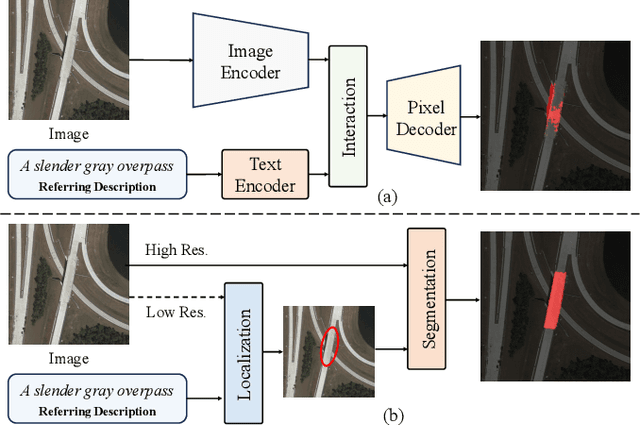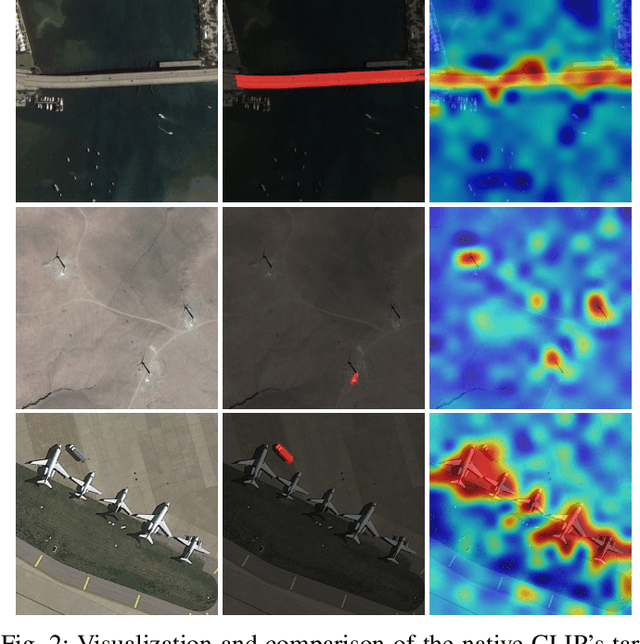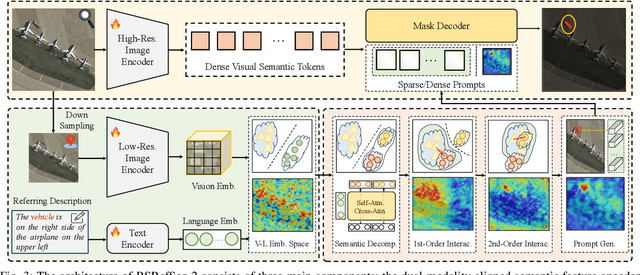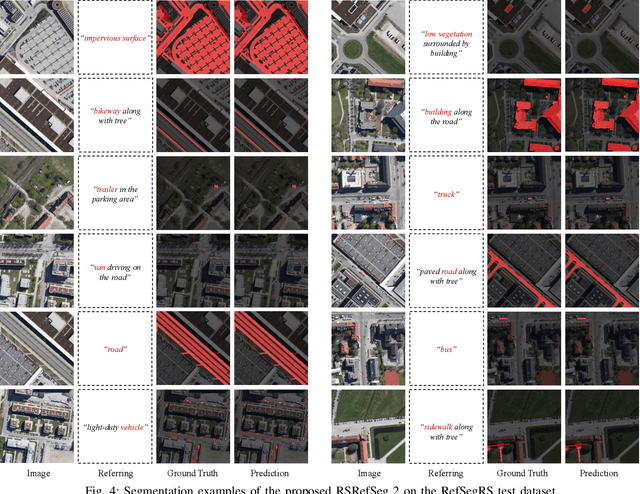Bowen Chen
RSRefSeg 2: Decoupling Referring Remote Sensing Image Segmentation with Foundation Models
Jul 08, 2025



Abstract:Referring Remote Sensing Image Segmentation provides a flexible and fine-grained framework for remote sensing scene analysis via vision-language collaborative interpretation. Current approaches predominantly utilize a three-stage pipeline encompassing dual-modal encoding, cross-modal interaction, and pixel decoding. These methods demonstrate significant limitations in managing complex semantic relationships and achieving precise cross-modal alignment, largely due to their coupled processing mechanism that conflates target localization with boundary delineation. This architectural coupling amplifies error propagation under semantic ambiguity while restricting model generalizability and interpretability. To address these issues, we propose RSRefSeg 2, a decoupling paradigm that reformulates the conventional workflow into a collaborative dual-stage framework: coarse localization followed by fine segmentation. RSRefSeg 2 integrates CLIP's cross-modal alignment strength with SAM's segmentation generalizability through strategic foundation model collaboration. Specifically, CLIP is employed as the dual-modal encoder to activate target features within its pre-aligned semantic space and generate localization prompts. To mitigate CLIP's misactivation challenges in multi-entity scenarios described by referring texts, a cascaded second-order prompter is devised, which enhances precision through implicit reasoning via decomposition of text embeddings into complementary semantic subspaces. These optimized semantic prompts subsequently direct the SAM to generate pixel-level refined masks, thereby completing the semantic transmission pipeline. Extensive experiments (RefSegRS, RRSIS-D, and RISBench) demonstrate that RSRefSeg 2 surpasses contemporary methods in segmentation accuracy (+~3% gIoU) and complex semantic interpretation. Code is available at: https://github.com/KyanChen/RSRefSeg2.
OMS: On-the-fly, Multi-Objective, Self-Reflective Ad Keyword Generation via LLM Agent
Jul 03, 2025Abstract:Keyword decision in Sponsored Search Advertising is critical to the success of ad campaigns. While LLM-based methods offer automated keyword generation, they face three major limitations: reliance on large-scale query-keyword pair data, lack of online multi-objective performance monitoring and optimization, and weak quality control in keyword selection. These issues hinder the agentic use of LLMs in fully automating keyword decisions by monitoring and reasoning over key performance indicators such as impressions, clicks, conversions, and CTA effectiveness. To overcome these challenges, we propose OMS, a keyword generation framework that is On-the-fly (requires no training data, monitors online performance, and adapts accordingly), Multi-objective (employs agentic reasoning to optimize keywords based on multiple performance metrics), and Self-reflective (agentically evaluates keyword quality). Experiments on benchmarks and real-world ad campaigns show that OMS outperforms existing methods; ablation and human evaluations confirm the effectiveness of each component and the quality of generated keywords.
Evidence-based diagnostic reasoning with multi-agent copilot for human pathology
Jun 26, 2025Abstract:Pathology is experiencing rapid digital transformation driven by whole-slide imaging and artificial intelligence (AI). While deep learning-based computational pathology has achieved notable success, traditional models primarily focus on image analysis without integrating natural language instruction or rich, text-based context. Current multimodal large language models (MLLMs) in computational pathology face limitations, including insufficient training data, inadequate support and evaluation for multi-image understanding, and a lack of autonomous, diagnostic reasoning capabilities. To address these limitations, we introduce PathChat+, a new MLLM specifically designed for human pathology, trained on over 1 million diverse, pathology-specific instruction samples and nearly 5.5 million question answer turns. Extensive evaluations across diverse pathology benchmarks demonstrated that PathChat+ substantially outperforms the prior PathChat copilot, as well as both state-of-the-art (SOTA) general-purpose and other pathology-specific models. Furthermore, we present SlideSeek, a reasoning-enabled multi-agent AI system leveraging PathChat+ to autonomously evaluate gigapixel whole-slide images (WSIs) through iterative, hierarchical diagnostic reasoning, reaching high accuracy on DDxBench, a challenging open-ended differential diagnosis benchmark, while also capable of generating visually grounded, humanly-interpretable summary reports.
XVerse: Consistent Multi-Subject Control of Identity and Semantic Attributes via DiT Modulation
Jun 26, 2025Abstract:Achieving fine-grained control over subject identity and semantic attributes (pose, style, lighting) in text-to-image generation, particularly for multiple subjects, often undermines the editability and coherence of Diffusion Transformers (DiTs). Many approaches introduce artifacts or suffer from attribute entanglement. To overcome these challenges, we propose a novel multi-subject controlled generation model XVerse. By transforming reference images into offsets for token-specific text-stream modulation, XVerse allows for precise and independent control for specific subject without disrupting image latents or features. Consequently, XVerse offers high-fidelity, editable multi-subject image synthesis with robust control over individual subject characteristics and semantic attributes. This advancement significantly improves personalized and complex scene generation capabilities.
SeG-SR: Integrating Semantic Knowledge into Remote Sensing Image Super-Resolution via Vision-Language Model
May 29, 2025Abstract:High-resolution (HR) remote sensing imagery plays a vital role in a wide range of applications, including urban planning and environmental monitoring. However, due to limitations in sensors and data transmission links, the images acquired in practice often suffer from resolution degradation. Remote Sensing Image Super-Resolution (RSISR) aims to reconstruct HR images from low-resolution (LR) inputs, providing a cost-effective and efficient alternative to direct HR image acquisition. Existing RSISR methods primarily focus on low-level characteristics in pixel space, while neglecting the high-level understanding of remote sensing scenes. This may lead to semantically inconsistent artifacts in the reconstructed results. Motivated by this observation, our work aims to explore the role of high-level semantic knowledge in improving RSISR performance. We propose a Semantic-Guided Super-Resolution framework, SeG-SR, which leverages Vision-Language Models (VLMs) to extract semantic knowledge from input images and uses it to guide the super resolution (SR) process. Specifically, we first design a Semantic Feature Extraction Module (SFEM) that utilizes a pretrained VLM to extract semantic knowledge from remote sensing images. Next, we propose a Semantic Localization Module (SLM), which derives a series of semantic guidance from the extracted semantic knowledge. Finally, we develop a Learnable Modulation Module (LMM) that uses semantic guidance to modulate the features extracted by the SR network, effectively incorporating high-level scene understanding into the SR pipeline. We validate the effectiveness and generalizability of SeG-SR through extensive experiments: SeG-SR achieves state-of-the-art performance on two datasets and consistently delivers performance improvements across various SR architectures. Codes can be found at https://github.com/Mr-Bamboo/SeG-SR.
HDRSDR-VQA: A Subjective Video Quality Dataset for HDR and SDR Comparative Evaluation
May 27, 2025Abstract:We introduce HDRSDR-VQA, a large-scale video quality assessment dataset designed to facilitate comparative analysis between High Dynamic Range (HDR) and Standard Dynamic Range (SDR) content under realistic viewing conditions. The dataset comprises 960 videos generated from 54 diverse source sequences, each presented in both HDR and SDR formats across nine distortion levels. To obtain reliable perceptual quality scores, we conducted a comprehensive subjective study involving 145 participants and six consumer-grade HDR-capable televisions. A total of over 22,000 pairwise comparisons were collected and scaled into Just-Objectionable-Difference (JOD) scores. Unlike prior datasets that focus on a single dynamic range format or use limited evaluation protocols, HDRSDR-VQA enables direct content-level comparison between HDR and SDR versions, supporting detailed investigations into when and why one format is preferred over the other. The open-sourced part of the dataset is publicly available to support further research in video quality assessment, content-adaptive streaming, and perceptual model development.
DynamicVis: An Efficient and General Visual Foundation Model for Remote Sensing Image Understanding
Mar 20, 2025Abstract:The advancement of remote sensing technology has improved the spatial resolution of satellite imagery, facilitating more detailed visual representations for diverse interpretations. However, existing methods exhibit limited generalization capabilities across varied applications. While some contemporary foundation models demonstrate potential, they are hindered by insufficient cross-task adaptability and primarily process low-resolution imagery of restricted sizes, thus failing to fully exploit high-resolution data or leverage comprehensive large-scene semantics. Crucially, remote sensing imagery differs fundamentally from natural images, as key foreground targets (eg., maritime objects, artificial structures) often occupy minimal spatial proportions (~1%) and exhibit sparse distributions. Efficiently modeling cross-task generalizable knowledge from lengthy 2D tokens (~100,000) poses a significant challenge yet remains critical for remote sensing image understanding. Motivated by the selective attention mechanisms inherent to the human visual system, we propose DynamicVis, a dynamic visual perception foundation model for remote sensing imagery. The framework integrates a novel dynamic region perception backbone based on the selective state space model, which strategically balances localized detail extraction with global contextual integration, enabling computationally efficient encoding of large-scale data while maintaining architectural scalability. To enhance cross-task knowledge transferring, we introduce a multi-instance learning paradigm utilizing meta-embedding representations, trained on million-scale region-level annotations. Evaluations across nine downstream tasks demonstrate the model's versatility. DynamicVis achieves multi-level feature modeling with exceptional efficiency, processing (2048x2048) pixels with 97 ms latency (6% of ViT's) and 833 MB GPU memory (3% of ViT's).
Text-Derived Relational Graph-Enhanced Network for Skeleton-Based Action Segmentation
Mar 19, 2025Abstract:Skeleton-based Temporal Action Segmentation (STAS) aims to segment and recognize various actions from long, untrimmed sequences of human skeletal movements. Current STAS methods typically employ spatio-temporal modeling to establish dependencies among joints as well as frames, and utilize one-hot encoding with cross-entropy loss for frame-wise classification supervision. However, these methods overlook the intrinsic correlations among joints and actions within skeletal features, leading to a limited understanding of human movements. To address this, we propose a Text-Derived Relational Graph-Enhanced Network (TRG-Net) that leverages prior graphs generated by Large Language Models (LLM) to enhance both modeling and supervision. For modeling, the Dynamic Spatio-Temporal Fusion Modeling (DSFM) method incorporates Text-Derived Joint Graphs (TJG) with channel- and frame-level dynamic adaptation to effectively model spatial relations, while integrating spatio-temporal core features during temporal modeling. For supervision, the Absolute-Relative Inter-Class Supervision (ARIS) method employs contrastive learning between action features and text embeddings to regularize the absolute class distributions, and utilizes Text-Derived Action Graphs (TAG) to capture the relative inter-class relationships among action features. Additionally, we propose a Spatial-Aware Enhancement Processing (SAEP) method, which incorporates random joint occlusion and axial rotation to enhance spatial generalization. Performance evaluations on four public datasets demonstrate that TRG-Net achieves state-of-the-art results.
TIMER: Temporal Instruction Modeling and Evaluation for Longitudinal Clinical Records
Mar 06, 2025Abstract:Large language models (LLMs) have emerged as promising tools for assisting in medical tasks, yet processing Electronic Health Records (EHRs) presents unique challenges due to their longitudinal nature. While LLMs' capabilities to perform medical tasks continue to improve, their ability to reason over temporal dependencies across multiple patient visits and time frames remains unexplored. We introduce TIMER (Temporal Instruction Modeling and Evaluation for Longitudinal Clinical Records), a framework that incorporate instruction-response pairs grounding to different parts of a patient's record as a critical dimension in both instruction evaluation and tuning for longitudinal clinical records. We develop TIMER-Bench, the first time-aware benchmark that evaluates temporal reasoning capabilities over longitudinal EHRs, as well as TIMER-Instruct, an instruction-tuning methodology for LLMs to learn reasoning over time. We demonstrate that models fine-tuned with TIMER-Instruct improve performance by 7.3% on human-generated benchmarks and 9.2% on TIMER-Bench, indicating that temporal instruction-tuning improves model performance for reasoning over EHR.
AI-driven 3D Spatial Transcriptomics
Feb 25, 2025



Abstract:A comprehensive three-dimensional (3D) map of tissue architecture and gene expression is crucial for illuminating the complexity and heterogeneity of tissues across diverse biomedical applications. However, most spatial transcriptomics (ST) approaches remain limited to two-dimensional (2D) sections of tissue. Although current 3D ST methods hold promise, they typically require extensive tissue sectioning, are complex, are not compatible with non-destructive 3D tissue imaging technologies, and often lack scalability. Here, we present VOlumetrically Resolved Transcriptomics EXpression (VORTEX), an AI framework that leverages 3D tissue morphology and minimal 2D ST to predict volumetric 3D ST. By pretraining on diverse 3D morphology-transcriptomic pairs from heterogeneous tissue samples and then fine-tuning on minimal 2D ST data from a specific volume of interest, VORTEX learns both generic tissue-related and sample-specific morphological correlates of gene expression. This approach enables dense, high-throughput, and fast 3D ST, scaling seamlessly to large tissue volumes far beyond the reach of existing 3D ST techniques. By offering a cost-effective and minimally destructive route to obtaining volumetric molecular insights, we anticipate that VORTEX will accelerate biomarker discovery and our understanding of morphomolecular associations and cell states in complex tissues. Interactive 3D ST volumes can be viewed at https://vortex-demo.github.io/
 Add to Chrome
Add to Chrome Add to Firefox
Add to Firefox Add to Edge
Add to Edge